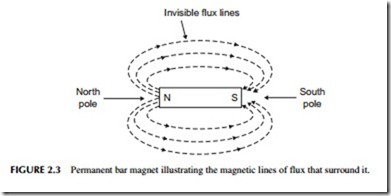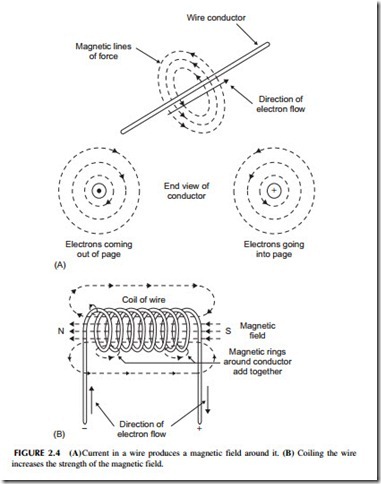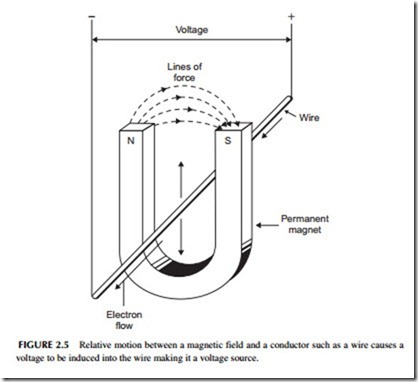MAGNETISM
You are probably asking, what does magnetism have to do with anything? As it turns out, it has lots to do with electricity and electronics. As you will see, the two are tied together significantly, meaning you need to know about both to get the big picture. Magnetism is essential to all electrical and electronic phenomena. Without magnetism, there would be no electricity or electronics.
Magnetic Fields
Magnetism is an invisible force that has the power to attract pieces of iron, or alloys of iron such as steel. Iron, steel, and the metals nickel and cobalt are called magnetic materials because they can be magnetized to generate a magnetic field, or they support the development and passage of a magnetic field. Magnets are pieces of such materials that exhibit this force. Magnetism has no effect on nonmagnetic materials such as other metals (aluminum, brass, etc.), or on objects made of wood, plastic, or glass.
Invisible flux lines
You have no doubt experienced the effects of magnetism yourself. You may have played with a horseshoe magnet as a kid, or used bar magnets like the one in Figure 2.3 in a school lab. And you most likely have used flat magnets to hold paper notes on your refrigerator or file cabinet. These are called permanent magnets because they retain their magnetic force indefinitely.
A magnet is surrounded by an invisible magnetic force field made up of magnetic lines of force or flux lines. These flux lines flow out of one end of the magnet, the north (N) pole, and into the other end, the south (S) pole, as shown in Figure 2.3. The ends of the magnet are the points of the heaviest con- centration of the magnetic field.
The basic law of magnetism follows: opposite poles attract, and like poles repel. When you get two permanent magnets together, the north and south poles will attract one another. On the other hand, two north poles will repel one another. Two south poles will also physically push away from one another. Permanent magnets are used in a variety of electrical and electronic equipment. Their most common use is in motors, where the attraction and repulsion of magnets create rotary motion.
Electromagnetism
Magnetism is also produced by electricity. Whenever electrons flow in a conductor, they produce a magnetic field. This effect is called electromagnetism. Figure 2.4A shows how the magnetic lines of force encircle a wire through which current is flowing. Note that the direction of the lines of force depends on the direction of the current flow.
The strength of the magnetic field around a wire depends on the magnitude of the current flowing. High current (composed of many electrons) produces a strong magnetic field. Despite the current amplitude, however, the magnetic field weakens because it spreads out quickly, even at a short distance from the wire.
If you make a coil out of the wire, as shown in Figure 2.4B, the lines of force around each turn are added together. The result is that a more powerful,
highly concentrated magnetic field is produced. In fact, the coil simulates a bar magnet with north and south poles.
As indicated earlier, the strength of the magnetic field depends on the cur- rent amplitude in the wire. High current produces a strong field. The magnetic field is also increased by coiling the wire, which helps concentrate the lines of force. The closer the turns of the wire, the stronger the field. You can also increase field strength for a given current level by simply adding more turns
to the coil. Strong electromagnets are made by tightly coiling together many turns of fine wire in several layers.
Another way to increase the strength of the magnetic field is to insert a bar or core of magnetic material inside the coil. Because flux lines flow easier in iron or steel than in air, an iron or steel bar inside the coil helps concentrate the lines of force. Most of the flux lines flow through the core because it represents a lower path of resistance than the surrounding air for the lines of force. The result is a very strong field.
Electromagnetic Induction
Another important principle of magnetism is electromagnetic induction. This principle states that whenever there is relative motion between a conductor and a magnetic field, a voltage will be induced into the conductor.
Refer to Figure 2.5. If the wire is moved up or down so that it cuts through the magnetic lines of force between the magnet poles, voltage will be induced in the wire and cause current to flow. Voltage will also be induced into the wire if the wire is held in a fixed location and the magnetic field is moved so that the flux lines cut across the wire. The wire actually becomes a voltage source. That voltage will cause current to flow. The direction of current flow in the wire depends on both the direction of the magnetic field and the direction of the relative motion between the magnetic field and the wire.
The amount of the induced voltage depends on the number of flux lines cut and the speed of cutting. The greater the number of lines of force, the higher the induced voltage and the greater the current flow. The highest induced volt- age occurs when the conductor cuts across the flux lines at a right angle. If the wire moves parallel with the lines of force, no voltage is induced.
The induced voltage can also be increased by coiling the wire. More turns passing through the magnetic field will produce greater induced voltage and current flow. The motion in the magnetic field causes a small voltage to be induced into each turn of wire. All of the voltages will add together to produce a higher voltage.
In the examples above, we have assumed that the magnetic field comes from a permanent magnet. However, it doesn’t really matter where the field comes from. An electromagnetic field works just as well. Electromagnetic induction is the principal method of generating electricity in the world. Most electrical power is produced by giant generators containing large coils of wire that rotate in a magnetic field. The generator or alternator in your car works the same way.


